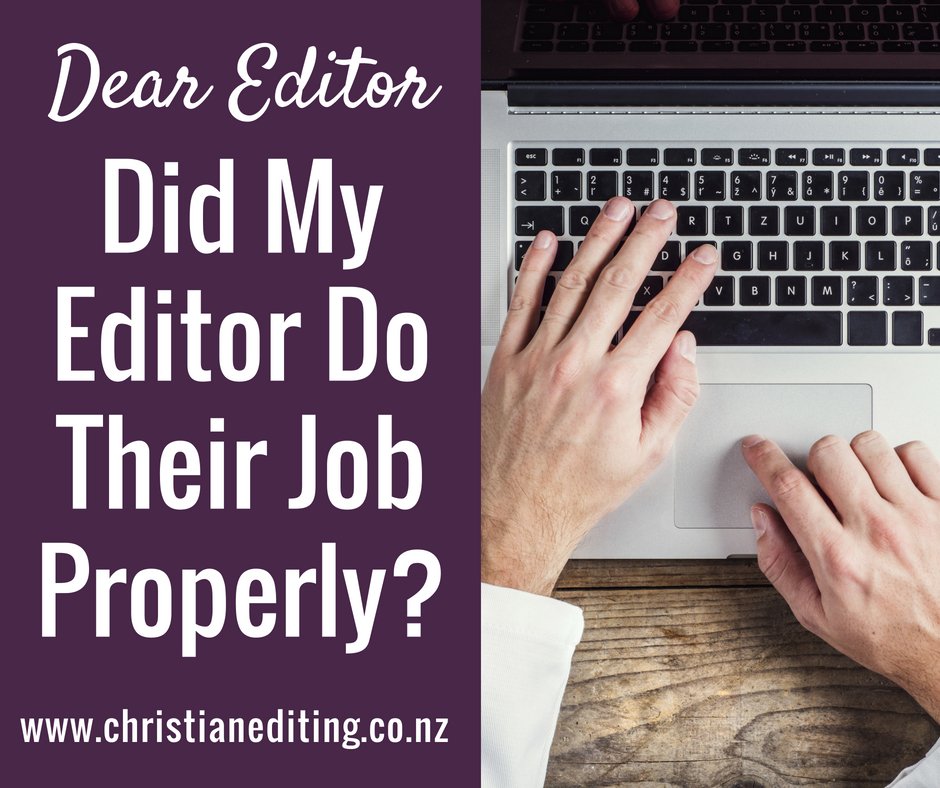I recently saw a comment in one of the Facebook groups I’m a member of. A fiction author was asking about editing standards, in relation to her recently released first novel. She said her editor picked up 50 to 60 mistakes in her 55,000-word novel, but the author had since found at least twelve errors the editor didn’t pick up, including mistakes like missing words.
That concerns me.
I’m not concerned that the editor apparently missed twelve mistakes. Twelve mistakes in a 55,000-word novel means the novel is 99.98% error-free.
I’d be happy with that.
I’m concerned because I don’t think the author understood the editing process enough to know that an editor who picks up less than 60 errors in a 55,000-word novel might not be an editor—at least, not in the way this author was thinking of editing. I’d expect to pick up this number of mistakes in a manuscript assessment. It’s possible this editor thought she was the developmental editor, not the copyeditor. If so, grammatical errors and missing words weren’t her job.
It’s possible the editor was claiming to be a copyeditor. If so, the author should have known from the low number of mistakes that the editor hadn’t done a thorough job.
(Although she should have been able to tell this from the sample edit. Always get a sample edit, even if you have to pay for it. If you’d like to request a free sample edit from me, contact me via the contact form on my About page.)
For example, I’ve recently completed a copyedit of a 40,000-word manuscript where I had over 2,300 queries or suggested changes. Most were small changes—remove a space here, add a comma there. Sometimes it takes two changes to correct one mistake.
My later proofread of the same manuscript had 300 suggestions, many of which related to the changes I’d suggested in the copyedit, but some where things I’d missed the first time around (often because I was focussing on another problem in that sentence or paragraph).
And that was a light edit—this is the author’s tenth published book, and her first six were with a major traditional publisher. She knows how to write. She’s been edited before. She expects this level of editing.
Dear author, if you only hired one editor, and she found less than 60 mistakes, then she missed things. A lot of things.
Let’s Talk About Editing
There are several different types of editing. A book from a traditional publisher will go through at least three rounds of editing, and several rounds of proofreading. Different editors use different terms, but here are the basic levels of editing:
Structural Editing
A high-level analysis of the plot, structure, characters, genre, and theme. The feedback is delivered in the form of an editorial letter, highlighting strengths and pinpointing areas the author needs to work on. Some authors use alpha readers or beta readers or critique partners for structural editing: you edit mine, and I’ll edit yours. The main point is that the editor (or critique partner) can go through the whole manuscript in one or two sittings, to get the big picture.
Developmental Editing
The editor works through the manuscript using Track Changes, commenting on big-picture issues like plot, characterisation, point of view, and showing vs. telling. This delivers similar feedback to the Structural Edit, except the author can see exactly where the problem is. The Structural Edit might say there is a problem with point of view. The Developmental Edit highlights each and every time there is a point of view violation. Some authors will use a critique group for this level of editing, swapping one or two chapters on a regular (e.g. weekly) basis.
Line Editing
Once the overall plot and characters work, the line editor gets to work. The Line Edit again uses Track Changes, and focuses on how the writing can be improved to deliver more emotion, more power. This includes things like cutting cliches, repetition, and telling, and reworking sentences and paragraphs to show the story the best way possible.
Copyediting
This is what most people think of as “editing”. It’s going through the manuscript (again using Track Changes) to focus on the spelling, grammar, and punctuation. It may also pick up or correct issues that either weren’t picked up during line editing, or have been introduced during revision. Some authors call this stage “proofreading” and work with a small group of nitpicky beta readers.
Proofreading
We finally get to proofreading. By this point, the novel should have been through several different paid and unpaid editors, beta readers, and/or critique partners. But there are always gremlins who sneak in, and that’s the proofreader’s job: to find and eliminate those last remaining gremlins. Ideally, the proofreader hasn’t read the book before, which means they have fresh eyes and will read the words on the page, not the words they remember being on the page last time.
Remember …
A good editor won’t just edit. They’ll tell why they are suggesting each change, and cite rules where applicable (e.g. . A good editor is a teacher and a coach as well as an editor. This is especially true for structural, developmental, and line editors. If you’re not getting that feedback, maybe it’s time to consider a different approach.

